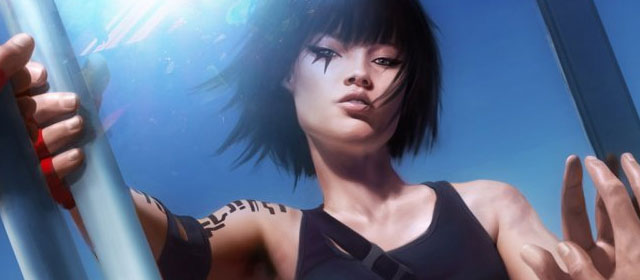Imagine how boring games and movies and literature would be if the concept of the dystopian future had never been developed, if we were allowed to believe that the future could be anything other than a high-tech Hell designed to constrain our creativity, hamstring our freedom and suppress our humanity. You only have to read Philip K. Dick or Orson Wells (or, if you like, watch the movies based on so many of their works) to become pretty depressed about the possibilities of tomorrow’s world.
Video games in particular work well within the confines of a dystopian future, as in every game that bows to the concept, there are caveats that make it bearable. Look at Deus Ex: Human Revolution as an example: it would be easy (or easier) to survive in a world where cybernetic augmentation has led to a totalitarian, militaristic regime if you just happen to be the most cybernetically-enhanced badass to ever wear a black leather trenchcoat. If you’re an average Joe who has to actually live in that future, that’s another matter.
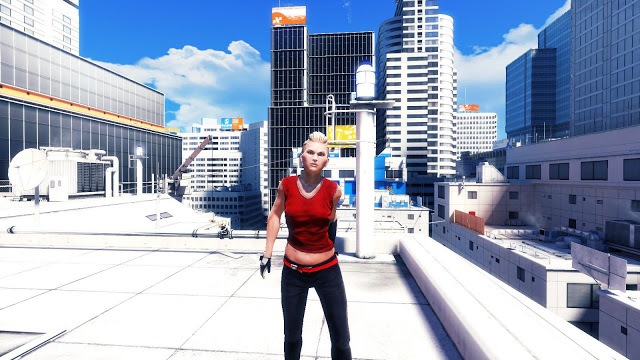
FAITH IN THE FUTURE: Take the world of Mirror’s Edge. Here is a much more 1984-style approach to dystopia, but one that’s no less worrying than some of the darker visions presented in films like Blade Runner or Dark City.
The setting of Mirror’s Edge is a future city in which the oppressor’s have won, to all intents and purposes and, outwardly at least, it would appear to be a more peaceful, stable and sustainable place to live than anywhere in the modern world. But of course, people will be people, and so a clean, healthy city where there’s no crime or poverty just doesn’t work. Life without pain has no meaning, or so they say, and the price of this new safe haven is too great for many to pay. Constant surveillance and censorship is married to efficient, often brutal punishments for those who would go against the law. Is the city safer? Yes. Is it cleaner? Yes. But can its citizens celebrate their humanity as they see fit, as is a right of every human being? No, they can’t – and therein lies the conflict.
Out of this seemingly bloody-minded rebellion, the Runners were born, individuals who know the secret highways, byways, back alleys and rooftop routes of the city and employ their own brand of breakneck parkour to deliver contraband and information under the radar of the City Police Force. In Mirror’s Edge, you play a Runner called Faith, dropped way over her head into the centre of a frightening conspiracy.
IT’S NOT NEWS ANYMORE, IT’S ADVERTISING: Developers DICE could have gone down a particular route with Mirror’s Edge and produced a game that had more fun with its core mechanics. I’m not saying Mirror’s Edge isn’t enjoyable, but there are times when you want to just run around like a mad person pulling off parkour tricks to your heart’s content. Unfortunately, although you can participate in a Time Trial mode, Mirror’s Edge is surprisingly po-faced otherwise.
The subject matter just doesn’t lend itself to dossing around. Faith is a Runner returning to duty after an unspecified accident forced her into hiatus. Joining fellow Runners Celeste, Kreeg and Drake – overseen by their eye-in-the-sky trainer Mercury – her first day back is interrupted by a distress call from her sister. Someone has assassinated Robert Pope – a mayoral candidate with a mind to relax many of the city’s more stringent laws – and Faith’s sister Kate is in the frame. To further complicate matters, Kate’s a cop, and the only person Faith can trust besides Merc is Lieutenant Miller, a mostly-honourable law-enforcer whose ethics become shaky when his own well-being is threatened.
The plot involves Project Icarus, a government initiative to train special agents in parkour with the sole aim being to take out the Runners once and for all, finally galvanising the police force’s hold on the city. Playing out in around 5 to 6 hours and light on the twists, the storyline of Mirror’s Edge is far from the game’s strong point, and the arguably odd decision to present the cutscenes as anime-style cartoons rather than game-engine CGI doesn’t do much to make it more compelling.
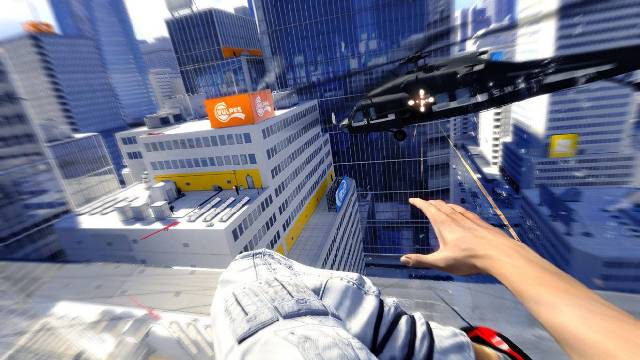
JUST KEEP RUNNING: Thankfully, this is counterbalanced more than adequately by the unique gameplay. If you only scanned still images of the game you could be forgiven for assuming that it’s just another FPS, but Mirror’s Edge is a title that actively encourages you not to use guns. For a start, the only way to get a firearm is to risk death to take it from an enemy, and you can’t pick up ammo refills; once it’s dry, you throw it away. Rather than shooting, you’re tasked only with running.
The majority of Mirror’s Edge takes place on the rooftops of the city, with hints towards the correct path given only by way of a stark red piece of scenery among the sterile, surgically-white-and-silver world. First-person platforming – though not perfect in DICE’s game – has never been more precise as you string together moves like wall-runs, backflips and knee-slides to get from A to B as quickly as possible. Faith can use the environment like a champion free-runner, and the control scheme couldn’t be simpler: LB is “up” and LT is “down” (on the 360, at least), meaning that to jump, leap, run along a wall or vault over an obstacle you hit the bumper, and to slide under boundaries or drop from ledges you hit the trigger. It’s easy to remember and doesn’t take long to feel incredibly natural.
Combat is best carried out on the fly, disarming or incapacitating enemies without breaking your stride and using your momentum to carry you through. The single hint of a Heads-Up Display is a tiny reticule in the centre of the screen, only added to stave off simulation sickness and give you something to focus on. This reticule will glow blue when your momentum is sufficient to activate Reaction Time, a bullet-time-style slo-mo mode that is especially handy when you need to relieve the filth of their nasty boomsticks.

NO MORE ICARUS: In terms of gameplay, Mirror’s Edge is its own worst enemy, caught between maddening difficulty and an over-compensating checkpoint system, resulting in a game that all too often strays dangerously close to becoming a trial-and-error slog. As well-crafted as it is, first-person platforming is almost impossible to get right and despite a high level of competence, Mirror’s Edge does stumble from time to time.
The first time through a new area at speed is exhilarating, but often your instinct will lead you to leap headlong to your death as you get caught up in your own momentum. Death means a checkpoint restart and a more sedate pace, which is at odds with how the game wants you to play. Correct routes are signposted by bright red objects that show up like spattered blood on the chrome and snow-white cityscape, but if you spot them late (or if you’re at a point later in the game where such hand-holding starts to become scarce), repeated death is guaranteed. It’s incredibly easy to allow yourself to slip into a culture of throwing Faith into peril until you luck upon the correct route.
Thankfully, it’s all very slick, smooth and intuitive, so it doesn’t take long to get a handle on the way Faith moves, but at times it feels as though DICE have intentionally inserted cheap, insta-death moments that they knew would catch people out. What the developers do nail is the feeling of movement itself – the head-bob, the pumping arms, the weight of each step and the shifting of balance. Combined with the absent HUD and minimal on-screen pop-up text, it creates a very immersive experience.
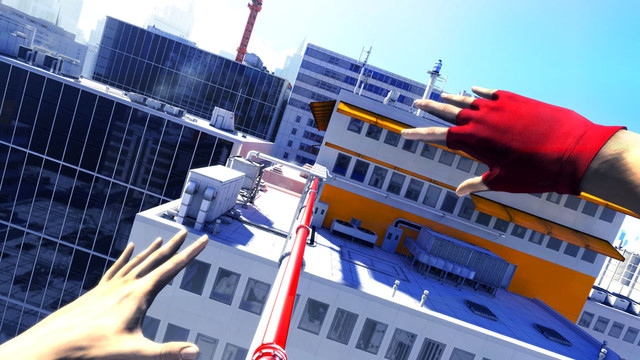
STILL ALIVE: The city itself is as important a character as any of the cast. Though not as deep or fleshed-out as some game-worlds, the mysterious, sterile playground of Mirror’s Edge is every inch the paradise-gone-wrong. From public service announcements advising the populace to watch out for signs that their children are hanging out with Runners to propaganda-style police recruitment posters; it’s all at odds with the stunning, glossy patina that coats the world.
The colours are vibrant and bold, the almost-complete lack of green lending the city a wonderfully industrial feel, the effect subconsciously adding to the oppressive, unfriendly atmosphere. It’s an obstacle course in its entirety, filled with wide rooftops and their many hazards and narrow, impromptu walkways, and the sense of vertigo is very real as you (for example) attempt to cross a slim wooden slat several hundred feet above street level. When Mirror’s Edge comes alive most is when Faith is either being chased or is dodging police-issue bullets to make a daring escape – this is when the deceptively-simple level design comes into play.
The routes are often hidden in plain sight, and you’re very rarely called upon to go off the beaten path. Exploration rewards you with collectibles that unlock artwork and achievements, but they’re not a major draw to any but the die-hard completionist. Both the greatest strength and greatest weakness of Mirror’s Edge’s level design is in making it look like you can go anywhere – it’s at once liberating and restricting, adding depth and scale to the world while avoiding the sense of over-whelming size that an open-world game might fall foul of, but holding you back from feeling truly free. You might argue that this is a deliberate choice, forcing you to feel as Faith feels: here’s a woman with the power, the skill and the ability to run free, trammelled behind the shiny bars of someone else’s perfect society, choked by someone else’s safety net.
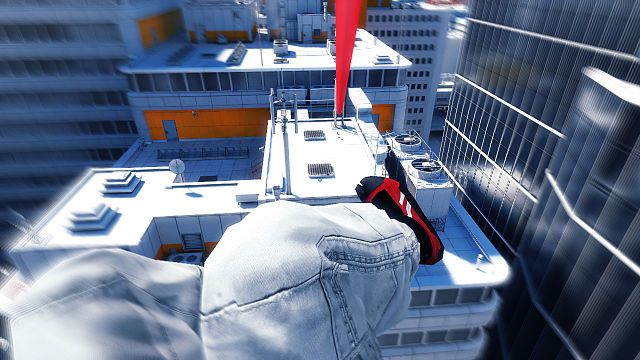
BETWEEN THE GLOSS AND THE REALITY: In many ways, Mirror’s Edge was, and still is unique. The low reliance on violence, the incredible art style and the core mechanic of the first-person platforming single it out as something very special, even if the characters themselves aren’t particularly compelling. Even protagonist Faith is an amalgam of video game heroines we’ve become familiar with; part Beyond Good & Evil’s Jade, part WET’s Rubi Malone, part Fear Effect’s Hana Tsu-Vaschel, part Lara Croft – there’s nothing about her that’s entirely original. Rihanna Pratchett’s script, too, is uncharacteristically lifeless, presenting a lacklustre mystery, forgettable, stock characters and an anti-climax brought about by the decision to leave the narrative open to a sequel that hasn’t happened yet.
The single greatest downside to Mirror’s Edge is the disparity between the gloss and the reality. On one side, it’s a beautiful, captivating – even mesmerising – game that presents an unusual vision of a bright-lit dystopia; on the other hand it’s an infuriatingly hit-and-miss parkour sim hamstrung by some odd design choices.
The reason it deserves to be replayed, however, is incredibly simple: no other game in the last five years has been anything like it. There are problems with the handling, the script takes itself a little too seriously and the glorious aesthetic is let down by sub-par animated cutscenes that would have been better served by the game’s engine, but the overall package is a well-made, well-realised first person platformer. In a world where the sequel is king and everyone borrows from everyone else, Mirror’s Edge stands alone.
Mirror’s Edge was developed by DICE and published by Electronic Arts. It currently holds a Metacritic score of 81/100.


